Tractatenblad van het Koninkrijk der Nederlanden
| Datum publicatie | Organisatie | Jaargang en nummer | Rubriek | Datum totstandkoming |
|---|---|---|---|---|
| Ministerie van Buitenlandse Zaken | Tractatenblad 2005, 257 | Verdrag |
Zoals vergunningen, bouwplannen en lokale regelgeving.
Adressen en contactpersonen van overheidsorganisaties.
U bent hier:

| Datum publicatie | Organisatie | Jaargang en nummer | Rubriek | Datum totstandkoming |
|---|---|---|---|---|
| Ministerie van Buitenlandse Zaken | Tractatenblad 2005, 257 | Verdrag |
Verdrag inzake verkeerstekens; (met Bijlagen)
Wenen, 8 november 1968
De tekst van Verdrag en Bijlagen is geplaatst in Trb. 1974, 36.
De Russische regering heeft in overeenstemming met artikel 41, eerste lid, wijzigingen van het Verdrag voorgesteld, welke de Secretaris-Generaal van de Verenigde Naties in overeenstemming met hetzelfde artikel/lid, op 28 september 2004 ter kennis heeft gebracht van alle Verdragsluitende partijen. De Engelse en de Franse tekst1 van de wijzigingsvoorstellen luiden als volgt:
Proposed amendments to the 1968 Vienna Convention on Road Signs and Signals
A. AMENDMENTS TO THE MAIN TEXT OF THE CONVENTION
Insert a new subparagraph e)bisto read:
``e)bis. `Cycle lane' means a part of a carriageway designated for cycles. A cycle lane is distinguished from the rest of the carriageway by longitudinal road markings."
Insert a new subparagraph e)terto read:
``e)ter. `Cycle track' means an independent road or part of a road designated for cycles, signposted as such. A cycle track is separated from other roads or other parts of the same road by structural means."
Replace the existing Article 7 by the following:
``1. It is recommended that domestic legislation provide that, in order to make them more visible and legible at night, road signs, in particular danger warning signs, regulatory signs and direction signs shall be lighted or retroreflective, provided that this does not result in road users being dazzled.
2. Contracting Parties may also allow the use of fluorescent materials; in this case they shall define which signs may make use of these materials.
3. Domestic legislation should draw up rules for the use of lighted, retroreflective and fluorescent signs. It should also specify the situations in which each class of retroreflective materials shall be used.
4. Dark or light graphic elements of different colours in the signs may be differentiated by means of contrasting light or dark narrow strips respectively.
5. Nothing in this Convention shall prohibit the use, for conveying information, warnings or rules applying only at certain times or on certain days, of signs which are visible only when the information they convey is relevant."
Paragraph 3
Amend to read:
``3. Nothing in this Convention shall prohibit the addition, mainly in order to facilitate the interpretation of signs, of an inscription in a rectangular panel below the sign or in a rectangular panel containing the sign; such an inscription may also be placed on the sign itself, if this does not make the sign more difficult to understand for drivers who cannot understand the inscription."
Paragraph 2
Amend to read:
``2. Regulatory signs placed level with or shortly after a sign indicating the beginning of a built-up area shall mean that the rule applies throughout the built-up area, unless a different rule is notified by other signs on certain sections of the road in the built-up area."
Insert a new paragraph 2bisto read:
``2. bis. Sign E, 11a shall be used for tunnels of 1,000 m or more and in cases provided for by domestic legislation. For tunnels of 1,000 m or more, the length shall be included either in the lower part of the sign, or on an additional panel H, 2, as described in Annex 1, section H. The name of the tunnel may be indicated according to Article 8, paragraph 3 of this Convention."
Paragraph 1
Amend to read:
``1. The marking of lanes reserved for certain categories of vehicles, including cycle lanes, shall be by means of lines which should be clearly distinguished from other continuous or broken lines on the carriageway, notably by being wider and with less space between strokes."
Paragraph 2
Amend the first sentence to read:
``2. If road markings are painted, they shall be yellow or white; however, blue may be used for markings showing places where parking is permitted but subject to some conditions or restrictions (limit of duration, payment, category of user, etc.). ..."
Paragraph 4
Amend to read:
``4. Road markings intended for moving vehicles shall be easily recognized in good time by drivers. They must be visible during the day and at night. It is recommended that such markings, especially in areas where lighting is insufficient, be retroreflective."
Insert a new article 29bisto read:
``1. When permanent road markings are to be modified for a specific period, in particular because of road works or diversions, temporary markings shall be applied in colours different from the colours used for permanent markings.
2. Temporary markings shall take precedence over permanent markings and road users are required to conform to them. When the simultaneous presence of permanent and temporary road markings could be a source of confusion, the permanent markings shall be covered over or removed.
3. Temporary markings shall preferably be retroreflective and may be supplemented by beacons, cats eyes or reflectors with a view to improving traffic guidance."
B. AMENDMENTS TO THE ANNEXES TO THE CONVENTION
Annex 1, section C, sub-section II (Descriptions)
Paragraph 9. (Prohibition or restriction of standing and parking)
Delete subparagraph c) (vii)
Annex 1, section D, sub-section II (Descriptions)
Paragraph 3. (Compulsory roundabout)
Amend to read:
``3. Sign D, 3 `COMPULSORY ROUNDABOUT', shall notify drivers that they must follow the direction at the roundabout indicated by the arrows. If the roundabout is indicated by the sign D, 3 together with the sign B, 1 or B, 2, the driver in the roundabout has priority."
Annex 1, section E, sub-section II (Descriptions)
Paragraph 9. (Signs notifying the entry or exit from a tunnel where special rules apply)
Replace the existing subparagraphs by the following:
``a) Sign E, 11a `TUNNEL' indicates a section of road passing through a tunnel and on which special traffic rules apply. It is placed at the point from which these rules apply.
b) In order to warn road users in advance, sign E, 11a may be placed in addition at a suitable distance before the point where the special rules apply; such sign shall show, either in its lower part, or on an additional panel H, 1, as described in section H of this Annex, the distance between the point at which it is set up and the point from which these special rules apply.
c) Sign E, 11b `END OF TUNNEL' may be placed at the point from which the special rules no longer apply."
Insert a new paragraph 14 to read:
``14. Signs indicating a stopping place in case of emergency or danger
Sign E, 17 `EMERGENCY STOPPING PLACE' indicates a place which shall only be used by drivers for stopping or parking in case of emergency or danger. If this stopping place is equipped with an emergency telephone and/or an extinguisher, the sign shall bear the symbols F, 14 and/or F, 15 either in its lower part or on a rectangular panel placed below the sign. This sign has two models, E, 17a and E, 17b."
Annex 1, section F, sub-section I (General characteristics and symbols)
Subparagraph 2
Amend the last sentence to read:
``2. ... The symbol shall be black or dark blue, except symbols F, 1a, F, 1b, F, 1c and F, 15, which shall be red. The symbol F, 14 may be red."
Annex 1, section F, sub-section II (Descriptions)
Paragraph 2. (Miscelleanous symbols)
Add the new symbols F, 14 and F, 15 below:
``F, 14 `EMERGENCY TELEPHONE"'
``F, 15 `EXTINGUISHER"'
Annex 1, section G, sub-section V (Indication signs)
Insert a new paragraph 11 to read:
``11. Signs indicating emergency exits
a) The signs G, 23a and G, 23b indicate the location of emergency exits.
b) The signs G, 24a, G, 24b and G, 24care examples of signs to indicate the direction and distance of the nearest emergency exits. In tunnels, they shall be placed at a maximum distance of 50 m apart and at a height of 1 to 1.5 m on the sidewalls.
c) The signs G, 23 and G, 24 have a green ground and the symbols, arrows and distance indications are white or of a light colour."
Reproduction below of the new signs and symbols introduced in the above proposed amendments:
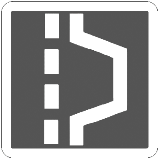
E, 17a

F, 14
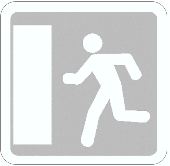
G, 23a
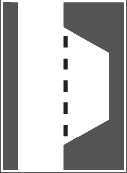
E, 17b

F, 15
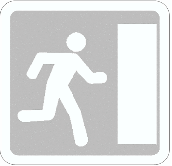
G, 23b

G, 24a

G, 24b

G, 24c
Propositions d'amendement à la Convention de 1968 sur la signalisation routière
A. AMENDEMENTS AU TEXTE PRINCIPAL DE LA CONVENTION
Insérer un nouvel alinéa e bis) libellé comme suit:
«e bis) Le terme «voie cyclable» désigne la partie d'une chaussée conçue pour les cycles. Une voie cyclable est séparée du reste de la chaussée par des marques routières longitudinales.»
Insérer un nouvel alinéa e ter) libellé comme suit:
«e ter) Le terme «piste cyclable» désigne une route indépendante ou la partie d'une route destinée aux cyclistes, et indiquée comme telle par des signaux. Une piste cyclable est séparée des autres routes ou des autres parties de la même route par des aménagements matériels.»
Remplacer l'article 7 actuel par le texte suivant:
«1. Il est recommandé que les législations nationales prévoient que, afin de les rendre plus visibles et lisibles la nuit, les signaux routiers, notamment les signaux d'avertissement de danger, les signaux de réglementation et les signaux de direction soient éclairés ou rétroréfléchissants, mais sans que cela entraîne l'éblouissement des usagers de la route.
2. Les Parties contractantes peuvent aussi permettre l'utilisation de matériaux fluorescents; dans ce cas elles doivent définir les signaux qui peuvent être munis de ces matériaux.
3. Les législations nationales devraient définir des règles d'usage des signaux éclairés, des signaux rétroréfléchissants et fluorescents. Elles devraient également préciser les situations dans lesquelles chacune des classes de matériaux rétroréfléchissants doit être utilisée.
4. Les symboles en différentes couleurs, foncées ou claires, utilisés sur les signaux peuvent être délimités par des bandes étroites contrastées, claires ou foncées, selon le cas.
5. Rien dans la présente Convention n'interdit d'employer, pour transmettre des renseignements, des avertissements ou des règles applicables seulement à certaines heures ou certains jours, des signaux dont les indications ne sont visibles que lorsque les renseignements qu'ils transmettent sont pertinents.»
Paragraphe 3
Modifier comme suit:
«3. Rien dans la présente Convention n'interdit d'ajouter, principalement pour faciliter l'interprétation des signaux, une inscription dans un panneau rectangulaire placé au-dessous des signaux ou à l'intérieur d'un panneau rectangulaire englobant le signal; une telle inscription peut également être placée sur le signal lui-même dans le cas où la compréhension de celui-ci n'en est pas gênée pour les conducteurs incapables de comprendre l'inscription.»
Paragraphe 2
Modifier comme suit:
«2. Les signaux de réglementation placés à l'aplomb d'un signal indiquant l'entrée de l'agglomération, ou peu après un tel signal, signifient que la réglementation s'applique dans toute l'agglomération, sauf dans la mesure où une autre réglementation serait notifiée par d'autres signaux sur certaines sections de la route dans l'agglomération.»
Insérer un nouveau paragraphe 2bis libellé comme suit:
«2bis. Le signal E, 11a doit être utilisé pour les tunnels de 1000m et plus et dans les cas prévus par la législation nationale. Pour les tunnels de 1000m et plus, la longueur doit être inscrite soit dans la partie inférieure du signal, soit sur un panneau additionnel H, 2 tel que décrit à l'annexe 1, section H. Le nom du tunnel peut être indiqué conformément au paragraphe 3 de l'article 8 de la présente Convention.»
Paragraphe 1
Modifier comme suit:
«1. Le marquage des voies réservées à certaines catégories de véhicules, y compris les voies cyclables, est réalisé au moyen de lignes qui se distinguent clairement des autres lignes continues ou discontinues apposées sur la chaussée, notamment par leur plus grande largeur et par les intervalles plus réduits entre les traits.»
Paragraphe 2
Modifier la première phrase comme suit:
«2. Si les marques sur la chaussée sont peintes, elles seront de couleur jaune ou blanche, la couleur bleue pouvant toutefois être employée pour les marques indiquant les emplacements où le stationnement est permis mais soumis à certaines conditions ou restrictions (durée limitée, paiement, catégorie d'usagers, etc.). ..»
Paragraphe 4
Modifier comme suit:
«4. Les marques routières destinées aux véhicules en mouvement doivent être reconnues aisément et à temps par les conducteurs. Elles doivent être visibles de jour comme de nuit. Il est recommandé que ces marques, notamment dans les zones où l'éclairage est insuffisant, soient rétroréfléchissantes.»
Insérer un nouvel article 29 bis libellé comme suit:
1. Lorsque des marques routières permanentes doivent être modifiées pour une période déterminée, notamment en raison de chantiers ou de déviations, il y a lieu d'apposer des marques temporaires de couleur différente de celles utilisées pour les marques permanentes.
2. Les marques temporaires prévalent sur les marques permanentes et les usagers de la route sont tenus de s'y conformer. Lorsque la présence simultanée d'un marquage permanent et d'un marquage temporaire peut être source de confusion, il y a lieu de masquer ou d'effacer les marques permanentes.
3. Les marques temporaires sont de préférence rétroréfléchissantes et peuvent être complétées par des balises, des plots ou des catadioptres en vue d'améliorer le guidage du trafic.»
B. AMENDEMENTS AUX ANNEXES DE LA CONVENTION
Annexe 1, section C, sous-section II (Description)
Paragraphe 9. (Interdiction ou limitation d'arrêt ou de stationnement)
Supprimer le point vii) à l'alinéa c).
Annexe 1, section D, sous-section II (Description)
Paragraphe 3. (Intersection à sens giratoire obligatoire)
Modifier comme suit:
«3. Le signal D,3 «INTERSECTION À SENS GIRATOIRE OBLIGATOIRE» notifie aux conducteurs qu'ils sont tenus de suivre les directions indiquées par les flèches au sens giratoire. Si le sens giratoire est signalé par le signal D,3 et par le signal B,1 ou B,2, le conducteur qui se trouve déjà sur l'intersection à sens giratoire a la priorité.»
Annexe 1, section E, sous-section II (Description)
Paragraphe 9. (Signaux annonçant l'entrée ou la sortie d'un tunnel où s'appliquent des règles particulières)
Remplacer les alinéas actuels par les suivants:
«a) Le signal E, 11a «TUNNEL» désigne un tronçon de route qui passe dans un tunnel et sur lequel s'appliquent des règles particulières. Il est placé à l'endroit à partir duquel ces règles s'appliquent.
b) Pour avertir les usagers à l'avance, le signal E, 11apeut en plus être placé à une distance adéquate avant l'endroit où les règles particulières s'appliquent; ce signal doit porter, soit dans sa partie inférieure, soit sur un panneau additionnel H, 1 tel que décrit à la section H de la présente annexe, la distance entre son point d'implantation et l'endroit à partir duquel ces règles particulières s'appliquent.
c) Un signal E, 11b «FIN DE TUNNEL» peut être placé à l'endroit à partir duquel les règles particulières ne s'appliquent plus.»
Insérer un nouveau paragraphe 14 libellé comme suit:
«14. Signaux annonçant une place d'arrêt en cas d'urgence ou de danger
Le signal E 17 «PLACE D'ARRET EN CAS D'URGENCE» indique un emplacement qui ne doit être utilisé par les conducteurs pour s'arrêter ou stationner qu'en cas d'urgence ou de danger. Si cette place d'arrêt est équipée d'un téléphone d'urgence et/ou d'un extincteur, le signal porte les symboles F, 14 et/ou F, 15 soit dans sa partie inférieure soit sur un panneau rectangulaire placé en dessous du signal. Ce signal comporte deux modèles: le E 17a et le E 17b.»
Annexe 1, section F, sous-section I (Caractéristiques générales et symboles)
Alinéa 2
Modifier la dernière phrase comme suit:
«2. ...Le symbole est noir ou bleu foncé, sauf les symboles F, 1a; F, 1b; F, 1c et F, 15 qui sont rouges. Le symbole F, 14 peut être rouge.»
Annexe 1, section F, sous-section II (Description)
Paragraphe 2. (Symboles divers)
Ajouter les nouveaux symboles F, 14 et F, 15 ci-après:
«F, 14 «TELEPHONE D'URGENCE»»
«F, 15 «EXTINCTEUR»»
Annexe 1, section G, sous-section V (Signaux d'indication)
Insérer un nouveau paragraphe 11 libellé comme suit:
«11. Signaux annonçant les issues de secours
a) Les signaux G, 23a et G, 23b indiquent l'emplacement des issues de secours.
b) Les signaux G, 24a, G, 24b et G, 24c sont des exemples pour indiquer la direction et la distance vers les issues de secours les plus proches. Dans les tunnels, ils ne doivent pas être distants les uns des autres de plus de 50 m et doivent être placés sur les parois à une hauteur de 1m à 1,5 m.
c) Les signaux G, 23 et G, 24 ont un fond de couleur verte et les symboles, les flèches et les indications des distances sont blanches ou de couleur claire.»
Reproduction ci-après des nouveaux signaux et symboles introduits dans les propositions d'amendement ci-dessus:
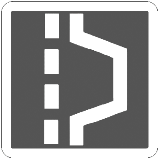
E, 17a
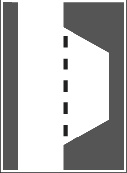
F, 14

G, 23a

E, 17b
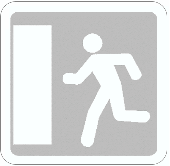
F, 15
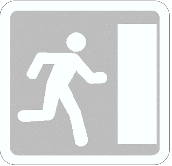
G, 23b

G, 24a

G, 24b

G, 24c
Zie Trb. 1974, 36 en 175.
De vertaling van de in rubriek B hierboven geplaatste wijzigingsvoorstellen luidt als volgt:
Voorgestelde wijzigingen van het Verdrag van Wenen van 1968 inzake verkeerstekens
A. WIJZIGINGEN VAN DE HOOFDTEKST VAN HET VERDRAG
Voeg de volgende nieuwe subparagraaf e)bis in:
„e)bis. ,Fietsstrook': een deel van de rijbaan dat voor fietsen bestemd is. Een fietsstrook wordt van de rest van de rijbaan onderscheiden door op het wegdek in de lengterichting aangebrachte tekens."
Voeg de volgende nieuwe subparagraaf e)ter in:
„e)ter. ,Fietspad': een aparte weg of deel van een weg bestemd voor fietsen en die of dat als zodanig wordt aangegeven. Een fietspad wordt van andere wegen of andere gedeelten van dezelfde weg gescheiden door fysieke maatregelen."
Het bestaande artikel 7 wordt vervangen door de volgende tekst:
„1. Het verdient aanbeveling dat de nationale wetgeving bepaalt dat, teneinde ze 's nachts beter zichtbaar en leesbaar te maken, verkeerstekens langs de weg, met name gevaarstekens, tekens die een bepaald voorschrift inhouden en richtingstekens verlicht zijn dan wel retroreflecterend zijn, mits dit er niet toe leidt dat weggebruikers erdoor worden verblind.
2. De Verdragsluitende Partijen mogen ook het gebruik van fluorescerende materialen toestaan; in dat geval moeten zij aangeven voor welke tekens deze materialen mogen worden gebruikt.
3. In de nationale wetgeving moeten regels worden opgesteld voor het gebruik van verlichte, retroreflecterende en fluorescerende tekens. De nationale wetgeving moet ook aangeven in welke situaties elke categorie retroreflecterende materialen moet worden gebruikt.
4. Donkere of lichte grafische elementen van verschillende kleuren in de tekens kunnen worden onderscheiden door middel van respectievelijk lichte of donkere smalle contrasterende strepen.
5. Niets in dit Verdrag verbiedt het gebruik van tekens die bedoeld zijn om informatie, waarschuwingen of voorschriften te geven, en die uitsluitend van toepassing zijn op bepaalde tijden of op bepaalde dagen, en die alleen zichtbaar zijn wanneer hetgeen zij kenbaar maken ter zake dienend is."
Derde lid
Als volgt wijzigen:
„3. Niets in dit Verdrag verbiedt de toevoeging, hoofdzakelijk teneinde het begrijpen van tekens te vergemakkelijken, van een opschrift op een rechthoekig bord onder het teken, of op een rechthoekig bord waarop tevens het teken is aangebracht; een dergelijk opschrift mag ook op het teken zelf worden geplaatst, indien zulks het begrijpen van het teken niet moeilijker maakt voor bestuurders die het opschrift niet kunnen begrijpen."
Tweede lid
Als volgt wijzigen:
„2. Tekens die een bepaald voorschrift inhouden en die op één lijn zijn geplaatst met het teken dat het begin van een bebouwde kom vermeldt, of kort daar achter, geven aan dat het voorschrift van toepassing is binnen de gehele bebouwde kom, tenzij door middel van andere tekens op bepaalde gedeelten binnen de bebouwde kom een ander voorschrift is aangegeven."
Voeg de volgende nieuwe paragraaf 2bis toe:
„2bis. Teken E, 11a moet worden gebruikt bij tunnels van 1000 m of meer en in de bij nationale wetgeving bepaalde gevallen. Bij tunnels van 1000 m of meer moet de lengte worden vermeld ofwel in het onderste gedeelte van het teken ofwel op een onderbord H, 2, als beschreven in Bijlage 1, Deel H. Overeenkomstig artikel 8, derde lid, van dit Verdrag mag de naam van de tunnel worden vermeld."
Eerste lid
Als volgt wijzigen:
„1. Het markeren van rijstroken die zijn voorbehouden aan bepaalde categorieën voertuigen, met inbegrip van fietsstroken, dient te geschieden door middel van strepen die zich duidelijk onderscheiden van andere doorgetrokken of onderbroken strepen op de rijbaan, met name door een grotere breedte van de streep en een kortere lengte van de onderbrekingen in de streep."
Tweede lid
De eerste volzin als volgt wijzigen:
„2. Indien tekens op het wegdek zijn geschilderd, dienen deze wit of geel te zijn; blauw mag echter worden gebruikt om plaatsen aan te geven waar parkeren is toegestaan onder bepaalde voorwaarden of met bepaalde beperkingen (beperkte duur, betaling, categorie gebruiker, enz.). ..."
Vierde lid
Als volgt wijzigen:
„4. Tekens op het wegdek die zijn bedoeld voor rijdende voertuigen moeten door bestuurders tijdig gemakkelijk kunnen worden herkend. Ze moeten overdag en 's nachts zichtbaar zijn. Het verdient aanbeveling dat deze tekens, in het bijzonder in gebieden met onvoldoende verlichting, retroreflecterend zijn.
Voeg de volgende nieuwe paragraaf 29bis toe:
„1. Wanneer vast aangebrachte tekens op het wegdek voor een bepaald tijdvak moeten worden gewijzigd, in het bijzonder vanwege wegwerkzaamheden of omleidingen, moeten tijdelijke tekens worden aangebracht in kleuren die afwijken van de kleuren die voor vast aangebrachte tekens worden gebruikt.
2. Tijdelijk aangebrachte tekens gaan boven vast aangebrachte tekens en weggebruikers moeten zich hieraan conformeren. Wanneer de gelijktijdige aanwezigheid van vast en tijdelijk aangebrachte tekens tot verwarring kan leiden, moeten de vast aangebrachte tekens worden bedekt of verwijderd.
3. Tijdelijk aangebrachte tekens moeten bij voorkeur retroreflecterend zijn en mogen worden voorzien van bakens, kattenogen of reflectoren om de verkeersgeleiding te verbeteren."
B. WIJZIGINGEN VAN DE BIJLAGEN VAN HET VERDRAG
Bijlage 1, Deel C, II (Beschrijvingen)
Paragraaf 9. (Verbod of beperking om stil te staan of te parkeren)
Subparagraaf c. vii) wordt verwijderd
Bijlage 1, Deel D, II (Beschrijvingen)
Paragraaf 3. (Verplichte rijrichting op verkeersplein)
Als volgt wijzigen:
„3. Teken D,3 VERPLICHTE RIJRICHTING OP VERKEERSPLEIN stelt bestuurders ervan in kennis dat zij op het verkeersplein de richting moeten aanhouden die door de pijlen wordt aangegeven. Indien het verkeersplein wordt aangeduid door teken D,3 tezamen met teken B,1 of B,2, dan heeft de bestuurder op het verkeersplein voorrang."
Bijlage 1, Deel E, II (Beschrijvingen)
Paragraaf 9. (Tekens die het begin of het einde aangeven van een tunnel waarin bijzondere regels van toepassing zijn)
De bestaande subparagrafen worden vervangen door de volgende tekst:
a. Teken E,11a TUNNEL duidt een wegtracé aan dat door een tunnel gaat en waarop bijzondere verkeersregels van toepassing zijn. Het teken wordt geplaatst op het punt van waar deze regels van toepassing zijn.
b. Teneinde weggebruikers van tevoren te waarschuwen, kan teken E,11a aanvullend op een geschikte afstand vóór het punt van waar de bijzondere regels van toepassing zijn, worden geplaatst; op een dergelijk teken moet in het onderste gedeelte ervan, of op een onderbord H,1, als omschreven in Deel H van deze Bijlage, de afstand worden vermeld tussen het punt waarop het is geplaatst en het punt van waar deze bijzondere regels van toepassing zijn.
c. Teken E,11b EINDE TUNNEL kan worden geplaatst op het punt van waar de bijzondere regels niet langer van toepassing zijn."
Voeg de volgende nieuwe paragraaf 14 toe:
„14. Tekens die een stopplaats in geval van nood of gevaar aangeven
Teken E,17 NOODSTOPPLAATS geeft een plaats aan die uitsluitend door bestuurders mag worden gebruikt om te stoppen of te parkeren in geval van nood of gevaar. Indien deze stopplaats is voorzien van een noodtelefoon en/of brandblusapparaat, is het teken voorzien van symbolen F,14 en/of F,15 in het onderste gedeelte ervan of op een rechthoekig bord onder het teken. Dit teken heeft twee modellen: E,17a en E,17b."
Bijlage 1, Deel F, I (Algemene kenmerken en symbolen)
Subparagraaf 2.
De laatste volzin wordt als volgt gewijzigd:
„2. ... Het symbool dient zwart of donkerblauw te zijn, behalve symbolen F,1a, F,1b, F,1c en F,15, die rood dienen te zijn. Symbool F,14 mag rood zijn."
Bijlage 1, Deel F, II (Beschrijvingen)
Paragraaf 2. (Diverse symbolen)
De onderstaande nieuwe symbolen F,14 en F,15 worden toegevoegd:
„F,14 NOODTELEFOON"
„F,15 BRANDBLUSAPPARAAT"
Bijlage 1, Deel G, V (Aanduidingstekens)
Voeg de volgende nieuwe paragraaf 11 toe:
,11. Tekens die nooduitgangen aanduiden
a. Tekens G,23a en G,23b duiden de plaats van nooduitgangen aan.
b. Tekens G,24a, G,24b en G,24c zijn voorbeelden van tekens voor de aanduiding van de richting en afstand van de dichtstbijzijnde nooduitgangen. In tunnels dienen deze op een afstand van ten hoogste 50 m uit elkaar en op een hoogte van 1 à 1,5 m op de zijmuren te worden aangebracht.
c. Tekens G,23 en G,24 hebben een groene achtergrond en de symbolen, pijlen en afstandsaanduidingen zijn wit of licht van kleur."
Bijlage 3 (WEERGAVE IN KLEUR VAN DE IN BIJLAGE 1 BEDOELDE TEKENS, SYMBOLEN EN BORDEN)
Weergave hieronder van de in de bovengenoemde voorgestelde wijzigingen geïntroduceerde nieuwe tekens en symbolen:
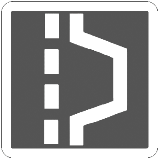
E, 17a

F, 14
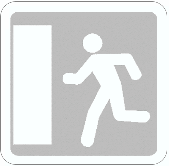
G, 23a
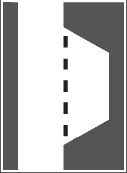
E, 17b

F, 15
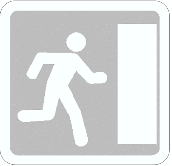
G, 23b

G, 24a

G, 24b

G, 24c
Zie Trb. 1974, 36.
De in rubriek B hierboven geplaatste wijzigingen, mits in overeenstemming met artikel 41, tweede lid, onderdeel a, van het Verdrag op 28 september 2005 door de partijen bij het Verdrag aangenomen behoeven, als integrerend deel van het Verdrag, ingevolge artikel 91 van de Grondwet de goedkeuring van de Staten-Generaal, alvorens het Koninkrijk aan het Verdrag, inclusief wijziging, kan worden gebonden.
Zie de rubrieken E en F van Trb. 1974, 36.
| Partij | Onder-tekening | Ratificatie | Type1) | Inwerking | Opzegging | Buitenwerking |
|---|---|---|---|---|---|---|
| Albanië | 06-02-04 | T | 06-02-05 | |||
| Bahrein | 04-05-73 | T | 06-06-78 | |||
| Belarus | 08-11-68 | 18-06-74 | R | 06-06-78 | ||
| België | 08-11-68 | 16-11-88 | R | 16-11-89 | ||
| Bosnië-Herzegovina | 12-01-94 | VG | 06-03-92 | |||
| Brazilië | 08-11-68 | |||||
| Bulgarije | 08-11-68 | 28-12-78 | R | 28-12-79 | ||
| Centraal Afrikaanse Republiek | 03-02-88 | T | 03-02-89 | |||
| Chili | 08-11-68 | 27-12-74 | R | 06-06-78 | ||
| Congo, Democratische Republiek | 25-07-77 | T | 25-07-78 | |||
| Costa Rica | 08-11-68 | |||||
| Cuba | 30-09-77 | T | 30-09-78 | |||
| Denemarken | 08-11-86 | 03-11-86 | R | 03-11-87 | ||
| Duitsland | 08-11-68 | 03-08-78 | R | 03-08-79 | ||
| Ecuador | 08-11-68 | |||||
| Estland | 24-08-92 | T | 24-08-93 | |||
| Filippijnen, de | 08-11-68 | 27-12-73 | R | 06-06-78 | ||
| Finland | 16-12-69 | 01-04-85 | R | 01-04-86 | ||
| Frankrijk | 08-11-68 | 09-12-71 | R | 06-06-78 | ||
| Georgië | 15-05-01 | T | 15-05-02 | |||
| Ghana | 22-08-69 | |||||
| Griekenland | 18-12-86 | T | 18-12-87 | |||
| Heilige Stoel | 08-11-68 | |||||
| Hongarije | 08-11-68 | 16-03-76 | R | 06-06-78 | ||
| India | 10-03-80 | T | 10-03-81 | |||
| Indonesië | 08-11-68 | |||||
| Irak | 18-12-88 | T | 18-12-89 | |||
| Iran | 08-11-68 | 21-05-76 | R | 06-06-78 | ||
| Italië | 08-11-68 | 07-02-97 | R | 07-02-98 | ||
| Ivoorkust | 24-07-85 | T | 24-07-86 | |||
| Joegoslavië (< 25-06-1991) | 08-11-68 | 06-06-77 | R | 06-06-78 | ||
| Kazachstan | 04-04-94 | T | 04-04-95 | |||
| Koeweit | 13-05-80 | T | 13-05-81 | |||
| Kroatië | 02-11-93 | VG | 25-06-91 | |||
| Letland | 19-10-92 | T | 19-10-93 | |||
| Litouwen | 20-11-91 | T | 20-11-92 | |||
| Luxemburg | 08-11-68 | 25-11-75 | R | 06-06-78 | ||
| Macedonië, Voormalige Joegoslavische Republiek | 20-12-99 | VG | 17-11-91 | |||
| Marokko | 29-12-82 | T | 29-12-83 | |||
| Mexico | 08-11-68 | |||||
| Mongolië | 19-12-97 | R | 19-12-98 | |||
| Noorwegen | 23-12-69 | 01-04-85 | R | 01-04-86 | ||
| Oekraïne | 08-11-68 | 12-07-74 | R | 06-06-78 | ||
| Oezbekistan | 17-01-95 | T | 17-01-96 | |||
| Oostenrijk | 08-11-68 | 11-08-81 | R | 11-08-82 | ||
| Pakistan | 14-01-80 | T | 14-01-81 | |||
| Polen | 08-11-68 | 23-08-84 | R | 23-08-85 | ||
| Portugal | 08-11-68 | |||||
| Roemenië | 08-11-68 | 09-12-80 | R | 09-12-81 | ||
| Russische Federatie | 08-11-68 | 07-06-74 | R | 06-06-78 | ||
| San Marino | 08-11-68 | 20-07-70 | R | 06-06-78 | ||
| Senegal | 19-04-72 | T | 06-06-78 | |||
| Servië en Montenegro | 12-03-01 | VG | 27-04-92 | |||
| Seychellen, de | 11-04-77 | T | 06-06-78 | |||
| Slowakije | 28-05-93 | VG | 01-01-93 | |||
| Spanje | 08-11-68 | |||||
| Tadzjikistan | 09-03-94 | T | 09-03-95 | |||
| Thailand | 08-11-68 | |||||
| Tsjechië | 02-06-93 | VG | 01-01-93 | |||
| Tsjechoslowakije (<01-01-1993) | 08-11-68 | 07-06-78 | R | 07-06-79 | ||
| Tunesië | 05-01-04 | T | 05-01-05 | |||
| Turkmenistan | 14-06-93 | T | 14-06-94 | |||
| Venezuela | 08-11-68 | |||||
| Verenigd Koninkrijk, het | 08-11-68 | |||||
| Zuid-Korea | 29-12-69 | |||||
| Zweden | 08-11-68 | 25-07-85 | R | 25-07-86 | ||
| Zwitserland | 08-11-68 | 11-12-91 | R | 11-12-92 |
1) DO=Definitieve ondertekening, R=Ratificatie, aanvaarding, goedkeuring of kennisgeving, T=Toetreding, VG=Voortgezette gebondenheid
Verklaringen, voorbehouden en bezwaren
Albanië, 11 maart 2004
....in accordance with article 46(2) of the above Convention, ...[Albania] ... has chosen model Aa as the danger warning sign, and model B, 2a as the stop sign.
Belarus, 18 juni 1974
The Byelorussian Soviet Socialist Republic does not consider itself bound by the provisions of article 44 of the Convention on Road Signs and Signals stating that disputes which relate to the interpretation or application of the Convention may be referred, at the request of any of the Parties concerned, to the International Court of Justice for decision.
The Byelorussian Soviet Socialist Republic declares that the provisions of article 37 of the Convention on Road Signs and Signals, under which a number of States may not become parties to the Convention, are discriminatory in character, and it considers that the Convention on Road Signs and Signals should be open for participation by all interested States without any discrimination or restriction.
The Byelorussian Soviet Socialist Republic declares that the provisions of article 38 of the Convention on Road Signs and Signals are anachronistic and at variance with the Declaration of the United Nations General Assembly on the Granting of Independence to Colonial Countries and Peoples (resolution 1514 (XV) of 14 December 1960).
België, 16 mei 1989
Reservations to articles 10 (6) and 23 (7), and annex 5, section F, 6.
Bulgarije, 8 november 1968
The People's Republic of Bulgaria declares that the provisions of article 37 of the Convention on Road Signs and Signals, under which a number of States may not become parties to this Convention, as discriminatory in character, and it considers that the Convention on Road Signs and Signals should be open for participation by all interested States without any discrimination or restriction.
The People's Republic of Bulgaria declares that the provisions of article 38 of the Convention on Road Signs and Signals are anachronistic and at variance with the Declaration of the United Nations General Assembly on the Granting of Independence to Colonial Countries and Peoples.
Bulgarije, 28 december 1978
The inscription of words on informative signs (i) to (v) inclusive of article 5, paragraph 1 c), shall be duplicated in the People's Republic of Bulgaria by a transliteration into Latin characters solely to indicate the terminal points of international routes passing through the People's Republic of Bulgaria and places of interest to international tourism.
In the People's Republic of Bulgaria mopeds are treated as motorcycles for the purposes of the application of the Convention on Road Signs and Signals [art. 46, para. 2 b)].
Congo, Democratische Republiek, 25 juli 1977
With reference to the pertinent provisions of the Convention Zaire shall not treat mopeds as motor cycles.
Cuba, 30 september 1977
The Republic of Cuba considers that the provisions of article 37 of the Convention, although concerned with matters which affect the interests of all States, are discriminatory in nature since they deny a number of States the right to sign or become a party to the Convention and this is contrary to the principle of the sovereign equality of States.
The Republic of Cuba declares that the provisions of article 38 of the Convention are no longer applicable because they are contrary to the Declaration on the Granting of Independence to Colonial Countries and Peoples (resolution 1514 (XV)), adopted by the United Nations General Assembly on 14 December 1960, which proclaims the necessity of bringing to a speedy and unconditional end colonialism in all its forms and manifestations.
The Revolutionary Government of the Republic of Cuba does not consider itself bound by the provisions of article 44 of the Convention, under which the International Court of Justice is to have compulsory jurisdiction in any dispute which may arise regarding the interpretation or application of the Convention. With regard to the competence of the International Court of Justice, Cuba maintains that, in order for a dispute to be submitted for settlement by the Court, the consent of all the parties concerned in the dispute must be obtained in each individual case.
The Republic of Cuba declares that it treats mopeds as motor cycles, in accordance with article 46 (2.b) of the Convention.
Denemarken, 3 november 1986
Reservation to article 27, paragraph 3 ``according to which `give way' shall be indicated both by transverse marking and a plate."
Duitsland, 3 augustus 1978
Ad article 10, paragraph 6
Article 10, paragraph 6, applies in the Federal Republic of Germany in accordance with paragraph 9 of the annex to the European Agreement of 1 May l97l supplementing the Convention on Road Signs and Signals.
Ad article 23, paragraph 7
The Federal Republic of Germany does not consider itself bound by article 23, paragraph 7, of this Convention.
Ad annex 5, section F, No. 6
The Federal Republic of Germany does not consider itself bound regarding the design of signs E, 19 and E, 20.
Estland, 24 augustus 1992
Estonia does not consider itself bound by article 44 of the Convention.
Finland, 1 april 1985
1. With respect to Article 10 paragraph 6 and Section B of Annex 2, paragraph 2 a) (iii) (Advance warning signs indicating obligatory stop):
Finland reserves the right to use as an advance warning sign indicating an obligatory stop the ``GIVE WAY" sign, supplemented with an additional panel including an inscription ``STOP" and indicating the distance to the obligatory stop;
2. With respect to Article 18 (Place identification signs):
Finland reserves the right not to use signs E, 9a or E, 9b to indicate the beginning of a built-up area or signs E, 9c or E, 9d to indicate the end of such an area. Instead of them symbols are used. A sign corresponding to sign E, 9b is used to indicate the name of a place, but it does not signify the same as sign E, 9b;
.....
4. With respect to Section F of Annex 5, paragraph 6 (Signs notifying a bus or a tramway stop): Finland reserves the right to use signs indicating a bus or a tramway stop which differ in shape and colour from signs E, 19 and E, 20.
Frankrijk, 9 december 1971
The French Government enters a reservation with regard to the application of article 10, paragraph 6, of the Convention on Road Signs and Signals in respect of metropolitan France and French overseas territories:
Decisions adopted under the Economic Commission for Europe provide for advance warning of sign B, 2a (Stop) by means of sign B, 1, supplemented by a rectangular panel bearing the ``Stop" symbol and a figure indicating the distance to sign B, 2a. This rule conflicts with the provisions of article 10 of the Convention.
Georgië, 15mei 2001
Onder de mededeling dat model Aa is gekozen als gevaarsteken en model B2a als stopteken.
Griekenland, 18 december 1986
[The Government of Greece] declares that it has no intention of treating mopeds as motorcycles.
Hongarije, 16 maart 1976
1. The wording of article 37, paragraph 1, of the Convention is at variance with the purposes and principles expressed in the Charter of the United Nations. All States, without any restriction, should be given the possibility of participating in the Convention.
2. The provisions of article 38 of the Convention, as such, are anachronistic and are not in conformity with the principles of contemporary international law or the present state of international relations, and they are at variance with the United Nations General Assembly resolution 1514 (XV) of 14 December 1960.
[The Presidential Council of the Hungarian People's Republic] considers itself bound by the provisions of article 10, paragraph 6, of the Convention, relative to the [advance warning signs for sign B, 2], subject to its tenor as defined in the European Agreement supplementary thereto.
India, 10 maart 1980
The Government of the Republic of India does not consider itself bound by the provisions of article 44 of the Convention.
India shall treat mopeds as motor cycles.
Indonesië, 8 november 1968
Indonesia does not consider itself bound by article 44.
In conformity with article 1 moped will be deemed as motor-cycle.
Irak, 18 december 1988
Ratification of this Convention by the Republic of Iraq shall under no circumstances signify recognition of or entry into any relations with Israel.
On 17 March 1989, the Secretary-General received from the Government of Israel the following objection: ``The Government of the State of Israel has noted that the instrument of accession of the Republic of Iraq to the [said] Convention contains a reservation in respect of Israel. In view of the Government of the State of Israel, such reservation which is explicitly of a political character is incompatible with the purposes and objectives of this Convention and cannot in any way affect whatever obligations are binding upon the Republic of Iraq under general international law or under particular Conventions. The Government of the State of Israel will, in so far as concerns the substance of the matter, adopt towards the Republic of Iraq an attitude of complete reciprocity."
Italië, 7 februari 1997
Onder de mededeling dat Model Aa is gekozen als gevaarsteken en model B2a als stopteken.
Ivoorkust, 24 juli 1985
Pursuant to article 46, paragraph 1, [of the Convention] the Republic of the Ivory Coast does not consider itself bound by the provisions of article 44, under which ``Any dispute between two or more Contracting Parties which relates to the interpretation or application of this Convention and which the Parties are unable to settle by negotiation or other means of settlement may be referred, at the request of any of the Contracting Parties concerned, to the International Court of Justice for decision".
Litouwen, 20 november 1991
The Republic of Lithuania does not consider itself bound by article 44 of the Convention.
Luxemburg, 25 november 1975
With regard to the provisions of article 10, paragraph 6:
The advance warning sign for sign B, 2a shall be sign B, 1, supplemented by a rectangular panel bearing the word ``Stop" and a figure indicating the distance to sign B, 2a.
With regard to the provisions of article 23, paragraph 7:
Red or yellow arrows shall be used on a black circular background.
Marokko, 29 december 1982
Morocco does not consider itself bound by the contents of article 44 thereof.
Morocco will treat mopeds as motor cycles.
Noorwegen, 1 april 1985
[For the text of a declaration regarding the application of the Convention to the territories of Svalbard and Jan Mayen see chapter XI.B.19.]
The Government of Norway shall not be bound by the provisions, in article 10 (6), annex 4 A (2) a) (iii), annex 4 A (2) a) (v) and annex 5 F (4) and (5) [of the Convention].
Oekraïne, 12 juli 1974
The Ukraine does not consider itself bound by the provisions of article 44 of the Convention on Road Signs and Signals stating that disputes which relate to the interpretation or application of the Convention may be referred, at the request of any of the Parties concerned, to the International Court of Justice for decision.
The Ukraine declares that the provisions of article 37 of the Convention on Road Signs and Signals, under which a number of States may not become parties to the Convention, are discriminatory in character, and it considers that the Convention on Road Signs and Signals should be open for participation by all interested States without any discrimination or restriction.
The Ukraine declares that the provisions of article 38 of the Convention on Road Signs and Signals are anachronistic and at variance with the Declaration of the United Nations General Assembly on the Granting of Independence to Colonial Countries and Peoples (resolution 1514 (XV) of 14 December 1960).
Oostenrijk, 11 augustus 1981
1. Article 10 (6) of the Convention on Road Signs and Signals is applied with the exception that the sign B, 2a is announced in advance by the sign B, 1 supplemented by a rectangular panel bearing the symbol ``STOP" and a figure indicating the distance to sign B, 2a.
2. Article 23 (1) a) (i), article 23 (2) and article 23 (3) of the Convention on Road Signs and Signals are applied with the exception that the green light may also be flashing. The flashing of the green light signifies that the green phase will end immediately.
3. Paragraph 6 (signs E, 19 and E, 20) of Annex 5, section F of the Convention on Road Signs and Signals is not applied.
Roemenië, 8 november 1968
The Socialist Republic of Romania does not consider itself bound by the provisions of article 44 of this Convention.
Roemenië, 9 december 1980
Declarations:
1. The Socialist Republic of Romania considers that the provisions of article 45 of the Convention on Road Traffic and of article 37 of the Convention on Road Signs and Signals are not in keeping with the principle according to which the international treaties whose object and purpose are of interest to the international community as a whole, should be opened to universal participation.
2. The Socialist Republic of Romania considers that maintaining the state of dependence of some territories to which reference is made in article 46 of the Convention of Road Traffic, article 38 of the Convention on Road Signs and Signals, article 3 of the European Agreement supplementing the Convention of Road Traffic and article 3 of the European Agreement supplementing the Convention on Road Signs and Signals are not in keeping with the United Nations Charter and with the documents adopted by the U.N. concerning the granting of independence to the colonial countries and peoples, including the Declaration on the principles of international law concerning the friendly relations and the co-operation between States according to the United Nations Charter, and which has unanimously been adopted by the United Nations General Assembly resolution No. 2625 (XXV) of 24 October 1970 and which solemnly proclaims the States' obligation to further the implementation of the principle of equal rights for the peoples and their right to dispose of themselves, in order to put a speedy end to colonialism.
Reservations:
The Socialist Republic of Romania does not consider itself bound by the provisions of article 52 of the Convention according to which any dispute between two or more Contracting Parties which relates to the interpretation or application of the Convention and which the Parties are unable to settle by negotiation or other means may be referred to the International Court of Justice at the request of any of the interested Contracting Parties.
The Socialist Republic of Romania considers that such disputes may be referred to the International Court of Justice for decision only with the consent of all Parties in dispute, for each case individually.
Russische Federatie, 7 juni 1974
The USSR does not consider itself bound by the provisions of article 44 of the Convention on Road Signs and Signals stating that disputeswhich relate to the interpretation or application of the Convention may be referred, at the request of any of the Parties concerned, to the International Court of Justice for decision.
The USSR declares that the provisions of article 37 of the Convention on Road Signs and Signals, under which a number of States may not become parties to the Convention, are discriminatory in character, and it considers that the Convention on Road Signs and Signals should be open for participation by all interested States without any discrimination or restriction.
The USSR declares that the provisions of article 38 of the Convention on Road Signs and Signals are anachronistic and at variance with the Declaration of the United Nations General Assembly on the Granting of Independence to Colonial Countries and Peoples (resolution 1514 (XV) of 14 December 1960).
Seychellen, de, 11 april 1977
In compliance with article 46 (2) of the Convention on Road Signs and Signals the Government of the Republic of Seychelles declares that [it] treats mopeds as motor cycles.
Spanje, 8 november 1968
In accordance with article 46, . . . Spain does not consider itself bound by article 44 and enters a reservation with respect to article 38.
Thailand, 8 november 1968
Ad article 13 bis, paragraph 2, and annex
Thailand will not be bound by article 44 of the Convention.
Thailand will consider mopeds as motor-cycles.
Tunesië, 5 januari 2004
In ratifying the accession to the Convention on Road Signs and Signals concluded at Vienna on 8 November 1968, the Republic of Tunisia declares that it does not consider itself bound by article 44 of the Convention and affirms that any dispute which relates to the interpretation or application of this Convention may be submitted to arbitration or to the International Court of Justice only after the prior consent of all the Parties concerned.
Tunesië, 20 februari 2004
....in accordance with article 46(2) of the above Convention, ... [Tunesia] ... has chosen model Aa as the danger warning sign, and model B, 2a as the stop sign.".
.....in accordance with article 45 (4) of the above Convention, ... the distinguishing sign chosen for display in international traffic on vehicles registered by Tunisia is: ``TN".
Zweden, 25 juli 1985
1. Instead of article 10, paragraph 6 of the Convention Sweden will apply the dispositions of paragraph 9 of the annex of the European Agreement supplementing the Convention on Road Signs and Signals.
2. With respect to annex 5, section F, paragraph 4, of the Convention, the signs E, 15 shall have a green ground.
3. With respect to article 44 of the Convention, Sweden opposes that disputes in which it is involved shall be referred to arbitration.
Zwitserland, 11 december 1991
Ad article 18, paragraph 2 and annex 5, section C
Switzerland does not consider itself bound by the provisions of article 18, paragraph 2 of annex 5, section C.
Ad article 29, paragraph 2, 2nd sentence
Switzerland does not consider itself bound by the provisions of article 29, paragraph 2, 2nd sentence.
Ad annex 4, section A, number 2, letter d)
Switzerland reserves the right to enact, in its domestic legislation, regulations specifying that signs C, 13aa and C, 13ab shall not prohibit drivers from also overtaking motor vehicles whose speed is limited to 30 km/hr.
Ad annex 5, section F, numbers 4 and 5
Switzerland does not consider itself bound by the introductory provision that signals E, 15; E, 16; E, 17; and E, 18 shall have a blue ground.
Text of the reservations made by Switzerland, as adapted in view of the entry into force of the amendments proposed by Belgium on 31 May 1994:
Ad article 13 bis, paragraph 2, and annex 1, section E, sub-section II, paragraph 7
Switzerland does not consider itself bound by the provisions of article 13 bis, paragraph 2, and annex 1, section E, sub-section II, paragraph 7.
Ad article 29, paragraph 2, 2nd sentence, article 26 bis, paragraph 1 and annex 2, chapter II, section G
Switzerland does not consider itself bound by article 29, paragraph 2, 2nd sentence, article 26 bis, paragraph 1 and annex 2, chapter II, section G.
Ad Annex 1, section C, sub-section II, paragraph 4, letter a)
Switzerland reserves the right to enact in its national legislation a regulation specifying that signs C, 13 aa and C, 13 ab shall not prohibit drivers from also overtaking motor vehicles whose maximum speed is limited to 30 km/h.
Ad article 10, paragraph 6, 2nd sentence
Switzerland reserves the right to provide in its national legislation, as an advance warning for sign B,2, for an identical sign with an additional panel (model H,1) as indicated in annex 1, section H.
Zie Trb. 1997, 26.
De bepalingen van de in rubriek B geplaatste wijzigingen zullen ingevolge artikel 41, tweede lid, onderdeel a, van het Verdrag in werking treden op 28 maart 2006, tenzij meer dan een derde van de Verdragsluitende partijen voor 28 september 2005 de Secretaris-Generaal hebben medegedeeld dat zij de wijzigingen verwerpen, dan wel dat zij wensen dat een conferentie wordt bijeengeroepen ter bestudering van de wijzigingen.
De bepalingen zullen ingevolge hetzelfde artikel niet gelden voor de partijen die de wijzigingsvoorstellen hebben verworpen of een conferentie wensten.
Zie voor verwijzingen en andere verdragsgegevens Trb. 1974, 36 en 175 en Trb. 1997, 26.
Het Verdrag wordt aangevuld door:
| Titel | : | Europese Overeenkomst tot aanvulling van het Verdrag inzake verkeerstekens dat op 8 november 1968 te Wenen voor ondertekening werd opengesteld; Genève, 1 mei 1971 |
| Laatste Trb. | : | Trb. 2005, 259 |
| Titel | : | Protocol inzake tekens op het wegdek, aanvulling op de Europese Overeenkomst tot aanvulling van het Verdrag inzake verkeerstekens dat op 8 november 1968 te Wenen voor ondertekening werd opengesteld; Genève, 1 maart 1973 |
| Laatste Trb. | : | Trb. 2005, 260 |
| Overige verwijzingen | ||
| Titel | : | Verdrag inzake het wegverkeer; Wenen, 8 november 1968 |
| Laatste Trb. | : | Trb. 2005, 256 |
| Titel | : | Handvest van de Verenigde Naties; San Francisco, 26 juni 1945 |
| Laatste Trb. | : | Trb. 2004, 240 |
| Titel | : | Statuut van het Internationaal Gerechtshof; San Francisco, 26 juni 1945 |
| Laatste Trb. | : | Trb. 1997, 106 |
| Titel | : | Statuut van de Internationale Organisatie voor Atoomenergie; New York, 26 oktober 1956 |
| Laatste Trb. | : | Trb. 2001, 135 |
Kopieer de link naar uw clipboard
https://zoek.officielebekendmakingen.nl/trb-2005-257.html
De hier aangeboden pdf-bestanden van het Staatsblad, Staatscourant, Tractatenblad, provinciaal blad, gemeenteblad, waterschapsblad en blad gemeenschappelijke regeling vormen de formele bekendmakingen in de zin van de Bekendmakingswet en de Rijkswet goedkeuring en bekendmaking verdragen voor zover ze na 1 juli 2009 zijn uitgegeven. Voor pdf-publicaties van vóór deze datum geldt dat alleen de in papieren vorm uitgegeven bladen formele status hebben; de hier aangeboden elektronische versies daarvan worden bij wijze van service aangeboden.
